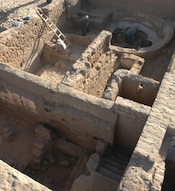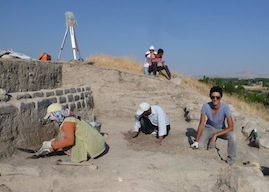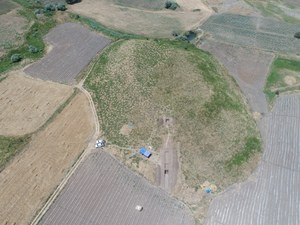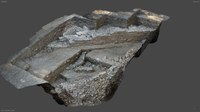Archaeological Projects
As a route to understanding the diverse civilizations of the ancient world and their interactions with one other through the study of material traces that have been left behind, the Institute for the Study of the Ancient World sponsors a robust program of archaeological fieldwork activity focusing on periods ranging from the 5th millennium BCE to the early medieval period. This program includes faculty-led projects in Egypt, Turkey, Iraqi Kurdistan, Uzbekistan, and China. ISAW faculty also contribute to fieldwork projects throughout the Mediterranean world and Asia Minor at sites such as Crete, Troy, and Kenchreai. In addition, ISAW visiting scholars currently lead or participate in fieldwork projects in Tunisia, Iraq, Mongolia, and China. ISAW offers training for students in archaeological theory, practice, and science; provides funding for students to participate in ISAW-sponsored and other fieldwork activity; and in some cases helps to facilitate students starting their own fieldwork projects.
The Oasis Wall Around Bukhara, Uzbekistan
Sören Stark
Territorial barrier-walls are a widespread phenomenon in many micro-regions of Western Central Asia where they often take the shape of large-scale oasis walls. One of the best-preserved examples of such a ‘long wall’, associated with a multitude of fortresses, forts and watch-towers, can be found around the oasis of Bukhara, one of Central Asia’s major urban centers. This project investigates these features by combining archaeological survey work with stationary excavations, and is carried out in cooperation with the Institute of Archaeology at the Academy of Sciences of Uzbekistan in Samarkand. See here for more information about our on-going research in the Bukhara region.
Amheida, Egypt
David M. Ratzan

NYU's excavations at the ancient city of Amheida (known as Trimithis in the Roman period) are a modern, multidisciplinary excavation by an international team of a large urban site with remains from the Old Kingdom to the late Roman period. Finds include the only known ancient school, mythological wall paintings, early churches. and the only standing mud-brick pyramid of the Roman period. As of 2022, we have published six substantial monographs on our work via ISAW Monographs, with several more currently in production. For more information, field reports, plans, images, database access, and bibliography, please visit: https://isaw.nyu.edu/research/amheida
Kınık Höyük, Nigde, Turkey
Lorenzo d’Alfonso
 A joint Italian-American team is excavating at Kınık Höyük, a pre-classical, intact site in southern Cappadocia, Turkey. This wealthy region once controlled the main passage through the Taurus mountains of the route connecting Europe and Asia. Finds and 14C dates indicate that the main occupation periods at the site starts at about 3000 BCE, and cover the Bronze Age, the post-Hittite, the Achaemenid, and Hellenistic periods, while a seasonal occupation of the summit of the site occurred in the Seljuk to Early Ottoman period.. The state of preservation of the Hellenistic and the Iron Age architecture excavated on the mound is unique in the region, so that restoration in addition to excavation is a main activity at Kınık, with the goal of opening an open-air museum. www.kinikhoyuk.org
A joint Italian-American team is excavating at Kınık Höyük, a pre-classical, intact site in southern Cappadocia, Turkey. This wealthy region once controlled the main passage through the Taurus mountains of the route connecting Europe and Asia. Finds and 14C dates indicate that the main occupation periods at the site starts at about 3000 BCE, and cover the Bronze Age, the post-Hittite, the Achaemenid, and Hellenistic periods, while a seasonal occupation of the summit of the site occurred in the Seljuk to Early Ottoman period.. The state of preservation of the Hellenistic and the Iron Age architecture excavated on the mound is unique in the region, so that restoration in addition to excavation is a main activity at Kınık, with the goal of opening an open-air museum. www.kinikhoyuk.org
The Chinese Bronze Age Economics Project
Roderick Campbell

The Chinese Bronze Age Economics Project is a multi-sited series of interrelated research collaborations led by ISAW professor Roderick Campbell involving several Chinese archaeological institutions and universities with the overarching goal of reconstructing the economy of Shang dynasty China (ca. 1600-1050 BCE). This research, begun in 2009, includes assemblage analyses at the Anyang period (1250-1050 BCE) capital, the contemporaneous secondary center of Daxinzhuang and the village site of Guandimiao. Specific research includes ongoing investigation of a large-scale bone crafting assemblage (~34 metric tons) excavated from Tiesanlu, Anyang, where millions of hairpins were mass-produced for broad-based consumption. Work at Daxinzhuang included an analysis of the bone artifact and bone working assemblages recovered from that site as well as bone tool replication experiments. Work at Guandimiao included zooarchaeological analysis, bone working analysis and ceramic production analysis. The comparison of production, exchange and consumption at these three sites has cast new light on the economy of the Anyang period Shang kingdom and generated numerous publications. Current work has shifted focus to the Erligang period (ca. 1600-1400 BCE) and the site of Zhengzhou Shangcheng – the capital of the Early Shang kingdom. Fieldwork in the summer of 2024 included bone working analysis at two loci of the ancient city as well as replication experiments in collaboration with the Henan Provincial Institute of Cultural Heritage and Archaeology. It is anticipated that more bone working as well as other craft industries will be studied in the future. The ultimate goal will be to generate updated models of the Shang economy as well as understand its changes over time. Research has been supported by Wenner-Gren, Luce-ACLS, NYU University Research Challenge and Ranieri grants as well as ISAW faculty research funds.
Gird-i Rostam, Iraqi Kurdistan
Daniel T. Potts
 Gird-i Rostam is a multi-period site in Iraqi Kurdistan occupied from the Chalcolithic period (c. 4400 BC) to late Antiquity (5th-7th cents. AD). After a brief mapping campaign in 2017 excavations began in 2018 as a joint project between ISAW and the Ludwig-Maximilians-University in Munich with the enthusiastic support of the Directorate of Antiquities in the Governate of Suleimaniyah and its Director Kamal Rasheed. Co-directed by Dan Potts and Karen Radner (Munich), the project aims to establish a sequence for this little-known, easternmost corner of Kurdistan which lies close to the Iranian border in the Zagros mountains. Die-stamped ceramics with Christian crosses; prehistoric obsidian from sources near Nemrut Dag in Turkey and Syunik in Armenia; painted pottery parallels in Luristan and northern Mesopotamia; and a vessel fragment with a cuneiform inscription naming the dedicant, in all probability of Neo-Assyrian date, already suggest that Gird-i Rostam is going to contribute enormously to our understanding of the prehistory and early history of the Zagros. A full preliminary report on the 2018 season is currently in press and will appear in the Dutch journal JEOL (Jaarbericht Ex Oriente Lux) in 2019 when another season of excavations is planned.
Gird-i Rostam is a multi-period site in Iraqi Kurdistan occupied from the Chalcolithic period (c. 4400 BC) to late Antiquity (5th-7th cents. AD). After a brief mapping campaign in 2017 excavations began in 2018 as a joint project between ISAW and the Ludwig-Maximilians-University in Munich with the enthusiastic support of the Directorate of Antiquities in the Governate of Suleimaniyah and its Director Kamal Rasheed. Co-directed by Dan Potts and Karen Radner (Munich), the project aims to establish a sequence for this little-known, easternmost corner of Kurdistan which lies close to the Iranian border in the Zagros mountains. Die-stamped ceramics with Christian crosses; prehistoric obsidian from sources near Nemrut Dag in Turkey and Syunik in Armenia; painted pottery parallels in Luristan and northern Mesopotamia; and a vessel fragment with a cuneiform inscription naming the dedicant, in all probability of Neo-Assyrian date, already suggest that Gird-i Rostam is going to contribute enormously to our understanding of the prehistory and early history of the Zagros. A full preliminary report on the 2018 season is currently in press and will appear in the Dutch journal JEOL (Jaarbericht Ex Oriente Lux) in 2019 when another season of excavations is planned.
Lyktos, Crete
Antonis Kotsonas
 Lyktos was one of the most powerful cities of the Mediterranean island of Crete, Greece, in the Greek and Roman periods (Figure 1). The site occupies a tall hill, which is set between high mountains and a vast plain, and commands a view of the Aegean Sea. Lyktos was celebrated by ancient authors, but attracted only limited fieldwork before the establishment of the Lyktos Archaeological Project in 2021. LAP is co-directed by ISAW’s Antonis Kotsonas and Professor Angelos Chaniotis, from the Institute for Advanced Study at Princeton; it involves the collaboration of Dr. Vasiliki Sythiakaki, from the Greek Archaeological Service, and runs under the auspices of the Archaeological Society at Athens. LAP is developing a longue durée approach to the history of Lyktos, but ISAW’s work at the site is centered on the exploration of both settlement and burial areas dating from the 6th century BCE, which is allegedly a “Dark Age” for the archaeology of Crete. By developing a problem-oriented approach and applying a range of methodologies from archaeological science, we hope to revolutionize the understanding of this Cretan Dark Age and to make broader contributions to discussions of period-specific problems of archaeological visibility in world archaeology. For more information see https://isaw.nyu.edu/research/lyktos.
Lyktos was one of the most powerful cities of the Mediterranean island of Crete, Greece, in the Greek and Roman periods (Figure 1). The site occupies a tall hill, which is set between high mountains and a vast plain, and commands a view of the Aegean Sea. Lyktos was celebrated by ancient authors, but attracted only limited fieldwork before the establishment of the Lyktos Archaeological Project in 2021. LAP is co-directed by ISAW’s Antonis Kotsonas and Professor Angelos Chaniotis, from the Institute for Advanced Study at Princeton; it involves the collaboration of Dr. Vasiliki Sythiakaki, from the Greek Archaeological Service, and runs under the auspices of the Archaeological Society at Athens. LAP is developing a longue durée approach to the history of Lyktos, but ISAW’s work at the site is centered on the exploration of both settlement and burial areas dating from the 6th century BCE, which is allegedly a “Dark Age” for the archaeology of Crete. By developing a problem-oriented approach and applying a range of methodologies from archaeological science, we hope to revolutionize the understanding of this Cretan Dark Age and to make broader contributions to discussions of period-specific problems of archaeological visibility in world archaeology. For more information see https://isaw.nyu.edu/research/lyktos.
For archaeological resources within the wider NYU network see the NYU Archaeohub.